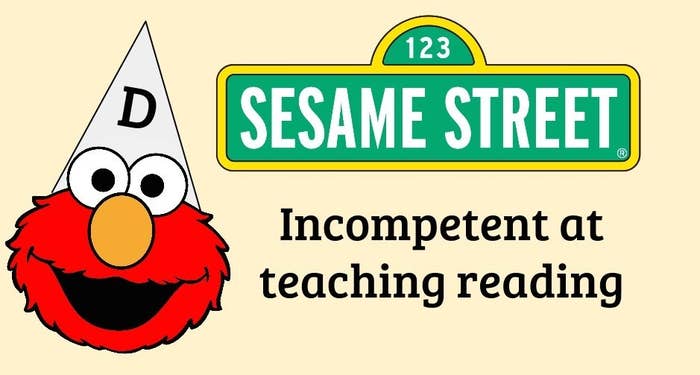
1 Always saying letter names, not sounds
Sesame Street relentlessly reinforces the names of the letters of the alphabet. Here's their own supercut of all the characters chanting letter names:
The problem with this is that English is not a phonetic alphabet. There are 44 sounds in English, represented by different combinations of letters. Chanting 'Ay' 'Bee' 'See' 'Dee' 'Ee' 'Eff' 'Gee' 'Aitch' (and so on) as the letters are shown is confusing. Knowing the names of letters is only useful when referring to them as symbols, not for actual reading. The sounds the letters represent are often different from their names - 'Aitch' has no /h/ sound at all in it.
If your child knows only the names of the letters in this way, seeing 'hat' will sound it out as Aitch Ay Tee, blend it into aitchytee, and have to guess what it actually means.
2 Explaining sounds with predicate logic
The very popular Sesame Street Alphabet video is trying to show letter/sound mapping:
But it gets it horribly wrong too. "Ay is for Abby, Bee is for Burt" at least does some mapping of letter to a common sound, but it again emphasises the letter name, and says it as a predicate, which is not something young children can model. Also, the video mostly uses character names, not concrete nouns, creating yet another arbitrary mapping to memorize.
If you're going to teach single sounds, repetition is better - Abby and an ant met an antelope, stressing the /a/ each time.
3 Treating words as memorization tasks
Here Big Bird looks at signs to learn new words. Notice the complete lack of breaking them down into sounds, but relying on recognising 'closed' and 'sale' and 'yarn'. Big Bird then sees a sign saying 'ABCDEFGHIJKLMNOPQRSTUVWXYZ' and guesses a pronunciation for it.
As adult readers, we do recognise words as a whole, but that is because we have built up experience over years of reading. This is a terrible strategy for young readers, firstly as they have no fallback strategy for words they haven't seen before, and secondly because it is hard to memorize that many symbols in the abstract. Even languages that do have a large number of word symbols, like Chinese and Japanese, teach in a phonetic way first.
Children who read with whole word memorisation can do well on picture books and simplified ones, but often fail completely when given more advanced books.
4 Getting sound mappings completely wrong
Susan explains that 'ABCDEFGHIJKLMNOPQRSTUVWXYZ' isn't a word to Big Bird about 3½ minutes into the video above.
However she then gives an incoherent explanation of how letters represent sounds: "See Ay Arr is Car" "See Ay Tee is Cat"
None of those are good representations of the component sounds of each word as it is /k/ /ar/ in the first word and /k/ /a/ /t/ in the second, not /s/ /ae/ /r/ and /s/ /ae/ /t/
There is an attempt at sounding out letters here, which is the fallback strategy children need for unknown words, but the examples and practice of it are completely opaque.
Children taught just letter names this way can puzzle out short words slowly, but get bogged down with longer words and end up guessing instead.
5 Obsessing over Alphabetical Order
Alphabetical order was a relatively late invention, as it is only something you need when organising a lot of printed matter. With Sesame Street, chanting the alphabet is often the only thing children do pick up. Alphabetical order is irrelevant- the letters only matter for reading to show the sounds of English.
There is a well-researched sequence to teach letters representing sounds:
• start with a subset of single letter consonants and vowels
• teach multi-letter sounds (like 'ch' and 'sh') next
• add more complex vowel sounds gradually
• then move on to spelling variations.
Sesame Street does have the problem of its initial form - as a series of broadcast TV programmes it can't know what children have already seen of it, so each one has to stand alone to some extent, but that flaw, along with the others above has been extended into the internet versions of the show.
Now this is not news - back in the 1970s, research showed that:
A significant difference was found in favor of the 1970 group on the alphabet subtest but not on any of the other subtests or on the total test.[…] It was concluded that Sesame Street was an effective teacher of letter recognition to kindergarten children, although the effects were not uniform.
Is Sesame Street actively harmful? When children are taught by these methods, an illiteracy rate of 33% to 42% is common - so a majority may well learn to read, and of course these aren't the only ways reading is taught. Sadly, all too many children are only taught in these clumsy, linguistically invalid ways.
More information on teaching reading: Why Our Children Can't Read and What We Can Do About It by Diane McGuinness
Does your child have reading difficulties? Heads Up Tutoring can help.




